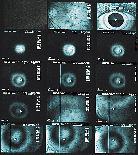SLO may be useful for postoperative evaluation of refractive surgery patients
Click Here to Manage Email Alerts
 ---The SLO image is demonstrating the very small useful optical zone, large transition zone and even a peripheral annular optical zone, untreated, all of this explaining the patient’s subjective complaints of diplopia.
---The SLO image is demonstrating the very small useful optical zone, large transition zone and even a peripheral annular optical zone, untreated, all of this explaining the patient’s subjective complaints of diplopia.
EDINBURGH, Scotland — Researchers are applying scanning laser ophthalmoscopy (SLO) to assess retinal and other causes of poor visual outcomes after refractive surgery.
Optical density of visual pigment or abnormal orientation of photoreceptors causes poorer visual performance even in the presence of a well-centered corneal ablation, said Marie Jose Tassignon, PhD, MD, of Antwerp, Belgium. She conducted a small trial of SLO to demonstrate its use in detecting wave front aberrations and to justify initiating a prospective study.
Quantifying aberration
 ---The SLO image shows a complicated case of radial keratotomy, where epithelial ingrowth was present.
---The SLO image shows a complicated case of radial keratotomy, where epithelial ingrowth was present.
Subjective visual comfort and objective visual performance of postrefractive surgery patients have been poorly evaluated until now, Dr. Tassignon said. Clinical studies often report good results for visual acuity and corneal topography, but a number of unaccounted-for complaints such as glare, halos, monocular diplopia and decreased sensitivity can reduce best-corrected visual acuity.
“It is remarkable that a disagreement often exists between the subjective visual comfort of the patient and the outcome of topographical examinations. The correspondence between SLO retinoscopy results and subjective outcomes is much better,” she said. The retinoscope images precisely indicate the corneal areas most responsible for glare and other adverse events, Dr. Tassignon said.
For the pilot study, she examined 60 postrefractive surgery patients to assess what conditions she could detect with SLO. Only a minority of patients had both preoperative and postoperative examinations.
Scanning laser retinoscopy allowed researchers to see patterns directly on the retina. The patterns revealed the wave front aberrations caused by refractive surgery, the optical density of the visual pigment and the alignment of the visual photoreceptors.
SLO demonstrates wave front aberrations in qualitative fashion, Dr. Tassignon said. The fundus may appear out of focus because the local wave front disturbances are seen as grayish-dark areas within the pupil for any given degree of spherical correction.
“This is both the strong point and weak point of the technique,” she said. “One can have an idea of the quality of the eye’s optics by simply looking at the fundus with the SLO under specific conditions. It would be much more difficult to quantify the amount of aberration. To do this, we are developing another technique also based on scanning laser ophthalmoscopy.”
Researchers intend to package new capabilities of the SLO into a dedicated instrument for refractive surgery. “Any institution with an SLO, using the appropriate parameters, can obtain such images that will give the user a fast, qualitative idea of the optical qualities of the eye,” she said. “We also are working on a quantitative method. This latter approach will be used to create capabilities in which the profiling of the cornea is guided in real-time by the outcome of the quantitative SLO test.”
For Your Information:
- Marie Jose Tassignon, PhD, MD, can be reached at University Hospital Antwerp, Wilrijkstraat, 10, 2650 Antwerp, Belgium; (32) 3-821-3377; fax: (32) 3-825-1926; e-mail: oftalmo@uia.ua.ac.be. Dr. Tassignon has no direct financial interest in the products mentioned in this article, nor is she a paid consultant for any companies mentioned.
